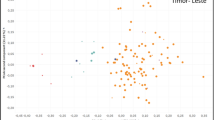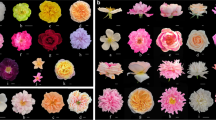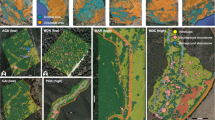Abstract
In northern Japan, coastal oak forests consist of Quercus dentata (Qd) on the coastal side and Q. mongolica var. crispula (Qc) on the inland side. In the forests of northern Hokkaido, Qd is rare, and a coastal ecotype of Qc with some Qd-like traits grows on the coastal side. To reveal the genetic background of this ecotype, nuclear microsatellite genotypes in closely related oak taxa were obtained from the Eurasian continent, Sakhalin, and Hokkaido. The clustering of these genotypes suggests an admixture of Qd in the coastal ecotype of Qc. Next, we evaluated the effects of admixture and coastal stress on the leaf and shoot traits of Qc and Qd along coastal–inland gradients in northern Hokkaido. The admixture of Qd in Qc was quantified by the Qd ancestry proportions. Coastal stress causes bud mortality in the upper parts of shoots and was quantified by the survival patterns of buds in shoots. The genetic and environmental effects on the traits at Qd-abundant and Qd-rare sites were estimated using linear mixed models. The genetic effect was detected in all traits. Both genetic and environmental effects were detected in most traits. Some traits differed between Qd-abundant and Qd-rare sites in addition to these effects, indicating more Qd-like traits at Qd-rare sites. The findings suggest that an admixture of Qd characterizes the genetic background of the coastal ecotype of Qc and that not only the coastal stress but also the genetic background is responsible for the leaf and shoot traits of Qc and Qd in northern Hokkaido.





Similar content being viewed by others
References
Aizawa M, Maekawa K, Mochizuki H et al (2018) Unveiling the origin of Quercus serrata subsp. mongolicoides found in Honshu, Japan, by using genetic and morphological analyses. Plant Species Biol 33:174–190. https://doi.org/10.1111/1442-1984.12207
Asai T, Shinmura Y, Usui G (1986) Mortality factors of the winter buds of Quercus dentata and Quercus mongolica var. grosseserrata in natural coastal forests of northern Hokkaido. J Jpn For Soc 68:368–374
Callaway RM, Pennings SC, Richards CL (2003) Phenotypic plasticity and interactions among plants. Ecology 84:1115–1128. https://doi.org/10.1890/0012-9658(2003)084[1115:ppaiap]2.0.co;2
Ciccarelli D (2015) Mediterranean coastal dune vegetation: Are disturbance and stress the key selective forces that drive the psammophilous succession? Estuar Coast Shelf Sci 165:247–253. https://doi.org/10.1016/j.ecss.2015.05.023
De Boeck P, Bakker M, Zwitser R et al (2011) The estimation of item response models with the lmer function from the lme4 package in R. J Stat Softw 39:1–28. https://doi.org/10.18637/jss.v039.i12
Doing H (1985) Coastal fore-dune zonation and succession in various parts of the world. Vegetatio 61:65–75. https://doi.org/10.1007/BF00039811
Eaton DAR, Hipp AL, González-Rodríguez A, Cavender-Bares J (2015) Historical introgression among the American live oaks and the comparative nature of tests for introgression. Evolution 69:2587–2601. https://doi.org/10.1111/evo.12758
Falush D, Stephens M, Pritchard JK (2003) Inference of population structure using multilocus genotype data: Linked loci and correlated allele frequencies. Genetics 164:1567–1587
Goulet BE, Roda F, Hopkins R (2017) Hybridization in plants: Old ideas, new techniques. Plant Physiol. https://doi.org/10.1104/pp.16.01340
Grime JP, Mackey JML (2002) The role of plasticity in resource capture by plants. Evol Ecol 16:299–307. https://doi.org/10.1023/A:1019640813676
Hasegawa S (1984) Basic studies on the conservation of the natural coastal forests in Hokkaido: The structure and regeneration of Quercus dentata Thunb. forest in Ishikari. Res Bull Hokkaido Univ For 41:313–422
Hiroki S (2017) A new scientific name proposed for a unique deciduous Quercus in Chubu and Kanto districts, Japan. J Phytogeogr Taxon 64:73–76
Ishida TA, Hattori K, Sato H, Kimura MT (2003) Differentiation and hybridization between Quercus crispula and Q. dentata (Fagaceae): Insights from morphological traits, amplified fragment length polymorphism markers, and leafminer composition. Am J Bot 90:769–776. https://doi.org/10.3732/ajb.90.5.769
Ito M (2009) Variation in leaf morphology of Quercus crispula and Quercus dentata assemblages among contact zones: a method for detection of probable hybridization. J For Res 14:240–244. https://doi.org/10.1007/s10310-009-0121-0
Kadomatsu M (1997) Differences in phenology of Quercus collected from northeast China, eastern Hokkaido and western Honshu. Res Bull Hokkaido Univ For 54:188–201
Kanazashi A, Kanazashi T (2009) Quercus mongolica Fischer ex Ledeb. var. crispula (Blume) Ohashi. In: Suzuki W, Ohsumi K, Yamanaka N (eds) Silvics of Japan, vol 1. Japan Forestry Investigation Committee, Tokyo, pp 635–667
Kanno M, Yokoyama J, Suyama Y et al (2004) Geographical distribution of two haplotypes of chloroplast DNA in four oak species (Quercus) in Japan. J Plant Res 117:311–317. https://doi.org/10.1007/s10265-004-0160-8
Khodwekar S, Gailing O (2017) Evidence for environment-dependent introgression of adaptive genes between two red oak species with different drought adaptations. Am J Bot 104:1088–1098. https://doi.org/10.3732/ajb.1700060
Kitamura K, Namikawa K, Kawahara T et al (2017) Genetic structure of remnant Quercus serrata populations at the northernmost limit of their distribution in Japan. Acta Phytotaxon Geobot 68:1–15
Lexer C, Kremer A, Petit RJ (2006) Shared alleles in sympatric oaks: Recurrent gene flow is a more parsimonious explanation than ancestral polymorphism. Mol Ecol 15:2007–2012. https://doi.org/10.1111/j.1365-294X.2006.02896.x
Liu H-Z, Harada K (2014) Geographic distribution and origin of the chloroplast T/C-type in Quercus mongolica var. crispula in northeastern Japan. Plant Species Biol 29:207–211
Matsumoto A, Kawahara T, Kanazashi A et al (2009) Differentiation of three closely related Japanese oak species and detection of interspecific hybrids using AFLP markers. Botany 87:145–153. https://doi.org/10.1139/B08-121
McVay JD, Hipp AL, Manos PS (2017) A genetic legacy of introgression confounds phylogeny and biogeography in oaks. Proc R Soc B Biol Sci 284:20170300. https://doi.org/10.1098/rspb.2017.0300
Mishima K, Watanabe A, Isoda K et al (2006) Isolation and characterization of microsatellite loci from Quercus mongolica var. crispula. Mol Ecol Notes 6:695–697. https://doi.org/10.1111/j.1471-8286.2006.01313.x
Miyabe K, Kudo Y (1925) Icones of the essential forest trees of Hokkaido, vol II. XII). Hokkaido Government, Sapporo
Muir G, Schlötterer C (2005) Evidence for shared ancestral polymorphism rather than recurrent gene flow at microsatellite loci differentiating two hybridizing oaks (Quercus spp.). Mol Ecol 14:549–561. https://doi.org/10.1111/j.1365-294X.2004.02418.x
Nagasaka Y, Kikuchi K, Yamazaki Y (1991) Growth pattern of natural coastal forest in North-Hokkaido: The structure of Quercus dentata forest in Teshio. Trans Hokkaido Branch Jpn For Soc 39:153–155
Ohashi H (1988) The new name instead of Quercus mongolica Fisch. var. grosseserrata (Bl.) Rehd. Wilis. (Fagaceae). J Jpn Bot 63:13–14
Ohba H (2006) Fagaceae. In: Iwatsuki K, Boufford DE, Ohba H (eds) Flora of Japan. Volume IIa. Kodansha, Tokyo, pp 42–60
Ohsawa T, Tsuda Y, Saito Y, Ide Y (2011) The genetic structure of Quercus crispula in northeastern Japan as revealed by nuclear simple sequence repeat loci. J Plant Res 124:645–654. https://doi.org/10.1007/s10265-010-0402-x
Okaura T, Quang ND, Ubukata M, Harada K (2007) Phylogeographic structure and late Quaternary population history of the Japanese oak Quercus mongolica var. crispula and related species revealed by chloroplast DNA variation. Genes Genet Syst 82:465–477. https://doi.org/10.1266/ggs.82.465
Ortego J, Gugger PF, Sork VL (2018) Genomic data reveal cryptic lineage diversification and introgression in Californian golden cup oaks (section Protobalanus). New Phytol 218:804–818. https://doi.org/10.1111/nph.14951
Patterson N, Price AL, Reich D (2006) Population structure and eigenanalysis. PLoS Genet 2:2074–2093. https://doi.org/10.1371/journal.pgen.0020190
Petit RJ, Bodénès C, Ducousso A et al (2004) Hybridization as a mechanism of invasion in oaks. New Phytol 161:151–164. https://doi.org/10.1046/j.1469-8137.2003.00944.x
R Core Team (2016) R: a language and environment for statistical computing. R Foundation for Statistical Computing, Vienna
Ramírez-Valiente JA, Sánchez-Gómez D, Aranda I, Valladares F (2010) Phenotypic plasticity and local adaptation in leaf ecophysiological traits of 13 contrasting cork oak populations under different water availabilities. Tree Physiol 30:618–627. https://doi.org/10.1093/treephys/tpq013
Rousset F (2008) GENEPOP’007: a complete re-implementation of the GENEPOP software for Windows and Linux. Mol Ecol Resour 8:103–106. https://doi.org/10.1111/j.1471-8286.2007.01931.x
Shimizu H (1997) Effects of geomorphological evolution on distribution of Quercus around the Sarobetsu peatland. Trans Hokkaido Branch Jpn For Soc 45:41–44
Shimizu H, Nagasaka Y, Yamazaki Y (1992) Local variation of bud number on current shoot of Quercus in North-Hokkaido. Trans Hokkaido Branch Jpn For Soc 40:220–222
Shimizu H, Kikuchi K, Yamada K (1994) Relationship between number of axillary buds of bud-scales and salt-spray resistance Quercus mongolica var. grosseserrata. Trans Hokkaido Branch Jpn For Soc 42:171–173
Shimizu H, Kikuchi K, Yamada K (1995) Local variation of bud number on axillary buds of bud-scales of Quercus dentata in coastal forest along Japan sea of Hokkaido. Trans Hokkaido Branch Jpn For Soc 43:140–142
Shinmura Y, Asai T, Usui G (1990) The relationships between environment and budbursting patterns of Quercus dentata and Quercus mongolica var. grosseserrata in natural coastal forests of northern Hokkaido. J Jpn For Soc 72:478–487
Ubukata M (2009) Quercus dentata Thunb. In: Suzuki W, Ohsumi K, Yamanaka N (eds) Silvics of Japan, vol 1. Japan Forestry Investigation Committee, Tokyo, pp 195–213
Ubukata M, Kohno K, Iizuka K (1996) Morphological characteristics of Quercus crispula × dentata hybrids. Trans Hokkaido Branch Jpn For Soc 44:113–116
Ubukata M, Itahana N, Kohno K (1999) Cross-compatibility between Quercus mongolica var. grosseserrata and Quercus dentata and both the reproductive ability and flowering time of their interspecific hybrids. J Jpn For Soc 81:286–290
Ueno S, Tsumura Y (2008) Development of ten microsatellite markers for Quercus mongolica var. crispula by database mining. Conserv Genet 9:1083–1085. https://doi.org/10.1007/s10592-007-9462-4
Ueno S, Taguchi Y, Tsumura Y (2008) Microsatellite markers derived from Quercus mongolica var. crispula (Fagaceae) inner bark expressed sequence tags. Genes Genet Syst 83:179–187. https://doi.org/10.1266/ggs.83.179
Ueno S, Aoki K, Tsumura Y (2009a) Generation of expressed sequence tags and development of microsatellite markers for Castanopsis sieboldii var. sieboldii (Fagaceae). Ann For Sci 66:509
Ueno S, Taguchi Y, Tomaru N, Tsumura Y (2009b) Development of EST-SSR markers from an inner bark cDNA library of Fagus crenata (Fagaceae). Conserv Genet 10:1477–1485. https://doi.org/10.1007/s10592-008-9764-1
Usui G, Shimizu H, Shinmura Y, Asai T (1988) A transformation model of asymmetric canopies of coastal forests. J Jpn For Soc 70:309–314
Valladares F, Gialoni E, Gómez JM (2007) Ecological limits to plant phenotypic plasticity. New Phytol 176:749–763. https://doi.org/10.1111/j.1469-8137.2007.02275.x
Yokoi S (2009) Quercus serrata Thunb. In: Suzuki W, Ohsumi N, Yamanaka N (eds) Silvics of Japan, vol 1. Japan Forestry Investigation Committee, Tokyo, pp 287–341
Acknowledgements
We thank the towns of Obira and Omu, as well as the Hokkaido Regional Forest Offices and the Soya and Kitami District Forest Offices, for their permission to collect samples; Ko Harada and Keiko Kitamura for providing DNA samples; Akiko Takazawa for her assistance in the laboratory work; Hiroki Itoh for his advice regarding statistical analyses; and Oliver Gailing, Ichiro Tamaki, and Kentaro Uchiyama for their suggestions for improving the manuscript. This study was supported by JSPS KAKENHI Grant Number 17K07859 to TN and Research Grant Number 201610 of the Forestry and Forest Products Research Institute to AN.
Author information
Authors and Affiliations
Corresponding author
Electronic supplementary material
Below is the link to the electronic supplementary material.
Rights and permissions
About this article
Cite this article
Nagamitsu, T., Shimizu, H., Aizawa, M. et al. An admixture of Quercus dentata in the coastal ecotype of Q. mongolica var. crispula in northern Hokkaido and genetic and environmental effects on their traits. J Plant Res 132, 211–222 (2019). https://doi.org/10.1007/s10265-018-01079-2
Received:
Accepted:
Published:
Issue Date:
DOI: https://doi.org/10.1007/s10265-018-01079-2




